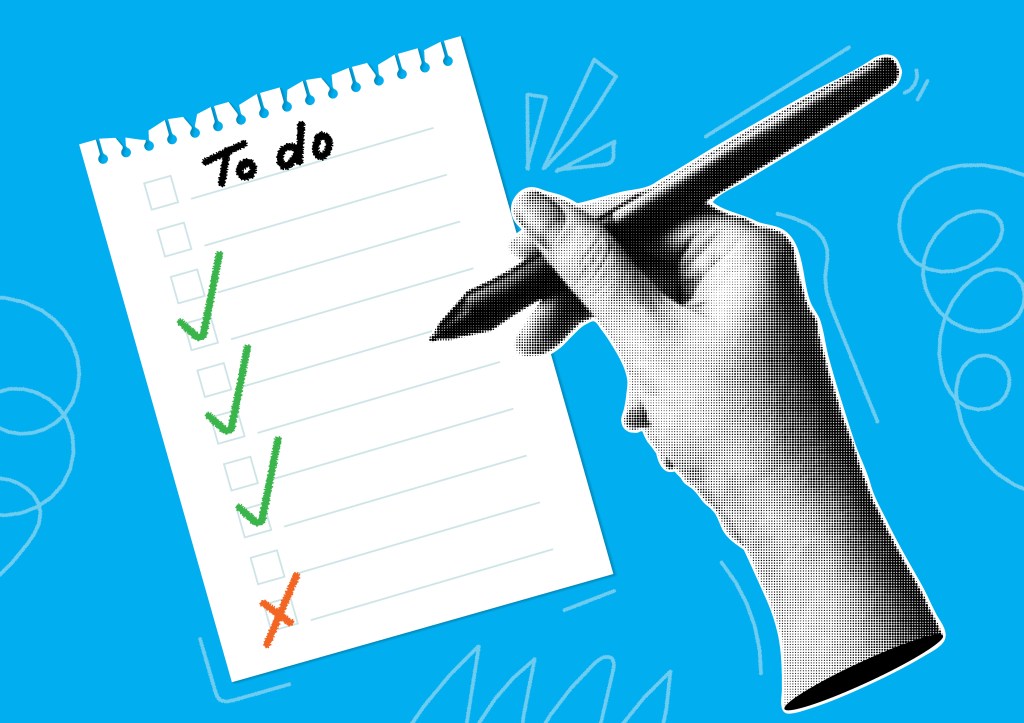Hypothetical for you: Two weeks ago, you were assigned a big work project to present this Monday. It’s now Sunday afternoon. Are you enjoying what’s left of your weekend or scrambling to put the presentation together?
If you relate more to the second option and now feel a bit sheepish about it, don’t. People procrastinate for a variety of reasons — perfectionism, neuroticism, low self-efficacy — but contrary to popular belief, laziness isn’t on the list. Rather than dive into the “why” regarding this topic, however, let’s focus on the “what now.” Among the numerous strategies for beating the behavior, one simple practice may be key: task decomposition.
Also called chunking, task decomposition is the act of breaking down a task into smaller, more manageable chunks — chunks that can be as simple as you need them to be (we’re talking “put sock on foot” simple).
Keep reading to learn why decomposition helps and how to best implement it.
How Decomposition Helps
It Can Break Us Out of the “Freeze” Response
As mentioned above, procrastination has many causes, including feeling overwhelmed. When we’re overwhelmed, our minds might go blank or we might feel paralyzed, unable to move forward. This is due to stress and perceived pressure activating our fight, flight, or freeze reaction. A great survival mechanism evolutionarily, but when something important needs to be done, it’s not super helpful.
“The dilemma of the modern world is our brains often can’t tell the difference between the threat level of ‘lion approaching’ and ‘assignment due,’” neuropsychotherapist Britt Frank, author of The Science of Stuck, told Nice News. Decomposing the scary task helps prevent an interruption to our regular pattern from becoming a threat.
“Brains don’t like pattern interruption. Since brains are wired primarily for efficiency and pattern recognition and not health and success, when we try to take on something big, the brain will resist and say ‘not braining today,’” Frank explained. “When you do what I call ‘micro-yeses,’ or breaking tasks down into such small pieces you feel ridiculous doing it, your brain doesn’t sense the interruption of a pattern and therefore won’t shift into a fear response.”
RELATED: OK, So Multitasking Is Impossible — What Should We Do Instead? An Expert Weighs In
It Creates a Positive Feedback Loop
It feels so good to check an item off a to-do list, doesn’t it? But if an entry is as broad as “plan Bob’s birthday party,” it’s going to be a lot harder to mark complete. Something like “Come up with five snack ideas for Bob’s birthday party,” on the other hand, is much easier — and thus it’s more likely that you reap the emotional reward of striking it off your list. That’s helpful because when we feel good, our motivation increases, resulting in a positive feedback loop.
“Motivation isn’t some magic fuel that shows up on command. In fact, it often follows action rather than precedes it,” psychologist Jeffrey Bernstein, author of The Anxiety, Depression & Anger Toolbox for Teens, explained in an email to Nice News, adding: “When you complete even one small piece of a task, it creates momentum. That feeling of ‘I did it’ — even if it’s something tiny — sparks dopamine in the brain and gives you a natural hit of motivation to keep going.”

Even better, the impact is exponential. “Each time you complete a chunk, you’re not just getting something done, you’re showing your brain, ‘I can do this.’ That’s powerful,” Bernstein pointed out. “And the more you do it, the more natural it becomes. Chunking isn’t just a motivational tool — it’s a learnable habit. The more we practice it, the more confident we feel, and that success compounds.”
How to Put Decomposition Into Practice
Figure Out the First Step
Whether your task is deep-cleaning your house or making a dentist appointment, start by figuring out the absolute first action you can take to make it happen. The brilliant part is that it can be as tiny an action as you like — anything you feel you can actually do in the moment when you’re feeling frozen.
“I’d start by asking, ‘What is the very, very first step I need to take to accomplish this task?’ If the answer is ‘get off the couch,’ that might still be too big. So then, you’d take your first step answer and break it down into 15 smaller steps,” Frank explained. “The very act of doing this task sometimes is enough to shift your brain into ‘go mode.’”
Get Out of Your Head
In a piece for Self, Frank advised that when we’re procrastinating, we should “get out of our heads and into our choices.” In other words, the tendency many of us have to self-analyze may be useful in other scenarios, but solving the mystery of why we procrastinate isn’t necessarily going to help us get something done.
Instead of thinking about the reasons you’re avoiding a task, start listing potential small steps on paper or saying them aloud. “Insight is good, but movement is better, at least at first,” Frank said.
Take Advantage of Tools
If the thought of breaking down a task feels like a task in and of itself, that’s fair. But there are handy tools that can help.

Magic ToDo by Goblin Tools is a free browser app that uses AI to break down any task — a user inputs something they need to get done, and the app breaks it down as much as the user needs. So “clean the bathroom,” for instance, becomes a 12-item checklist that’ll start with something like “gather your cleaning supplies such as a broom, mop, scrub brush, and cleaning solutions.” If a step is still too daunting, click “break down item” for an additional checklist, and so on.
Another idea — courtesy of Alice Boyd, author of Stress-Free Productivity — is to use ChatGPT or another AI platform to generate ideas and direction.
“I’ve found that this can make the process feel less lonely and daunting, as it’s like having an endlessly patient and enthusiastic teammate,” Boyd explained in a piece for Psychology Today, adding: “Use constraints as a thinking tool — ask it how you could straighten up your house in the next 30 minutes because someone judgmental is about to arrive.”
“Swiss Cheese It”
A variation on the idea of breaking down a task into specific, smaller tasks is breaking down big tasks into smaller chunks of time. The benefit of this method is that you cut through the step of naming and labeling tasks, and instead just focus on the time constraint without setting expectations of what you’ll accomplish within it.
“For example, try spending about ten minutes just jotting down ideas that come to mind on the topic of a paper, or skimming over a long reading to get just the main ideas,” Dominic J. Voge, former senior associate director of Princeton University’s McGraw Center for Teaching and Learning, wrote in a journal article. “After doing this several times on a big task, you will have made some progress on it, you’ll have some momentum, you’ll have less work to do to complete the task, and it won’t seem so huge because you’ve punched holes in it (like Swiss cheese). In short, it’ll be easier to complete the task because you’ve gotten started and removed some of the obstacles to finishing.”
When you buy books through our links, Nice News may earn a commission, which helps keep our content free.
RELATED: You Got This: 9 Time Management Methods to Increase Productivity and Reduce Stress











